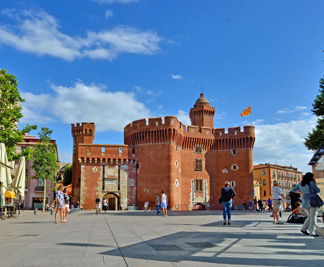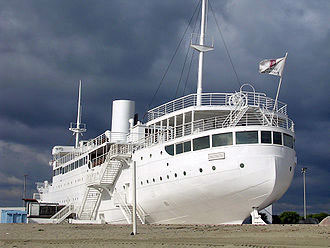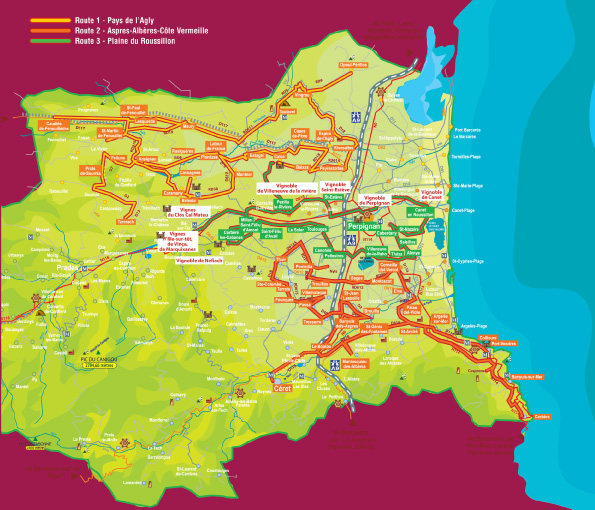 |
| The Independent Traveler's Newsletter PAGE FOUR |
 |
| The Independent Traveler's Newsletter PAGE FOUR |
|
The
Pyrénées-Orientales . . . continued Perpignan The arrondissement of Perpignan is a very good holiday destination, receiving very little rain during the year, with the most falling between October and December, and enjoying the most sunshine between May and September. It borders the Aude département on the north, the Mediterranean on the east, Prades to the west and Ceret to the south. Unlike other areas of the Pyrénées-Orientales, it does not have a border with Spain.   The city of Perpignan offers visitors a wide variety of attractions. It is a major stronghold for rugby, a sport popular elsewhere in the south of France. It's league plays under the name Catalans Dragons and competes in the Heineken Cup and has been seven times champion of the French Top 14, most recently in 2009. For those with little or no interest in rugby, there is the Cathedral of St-John the Baptist (Basilique-Cathédrale de Saint-Jean-Baptiste de Perpignan) whose construction began in 1324 by King Sancho of Majorca when Perpignan ruled Majorca. It wasn't finished until the 16th century replacing the Cathedral of Elna. You might also pay a visit to the restored 13th-century Palace of the Kings of Majorca [photo right], surrounded by ramparts, reinforced over the years for kings and updated for Louis XIV in the 17th century by Vauban.
The walls around Perpignan were also
designed by Vauban, the military engineer so valued by the kings of
France, but those were taken down in the early 1900s to make way for
urban development. There is a primary door to the city, the Castillet [photo left], which is a small fortress from
the 14th century and still stands today.  Le Baccarès, and perhaps more interesting, Port-Baccarès, is very close to Port Leucate in the Aude département to the north. It is on the beach at Port-Baccarès that you will see the newly painted, deliberately beached passenger liner, the Lydia, a 1931 Australian ship sold to a Greek shipping line in the mid 1950s. Built in Denmark, it was originally named the Moonta by the Adelaide Steamship Company and sailed around Australia. In 1955 it was sold to a Greek company and sailed the Mediterranean under the new name Lydia until being retired twelve years later. A development company, at great expense and with much effort, 'beached' the Lydia in Port-Baccarès, and it changed ownership a few times before finally receiving much needed renovations by its new owners, a French group, that added restaurants, a disco and a casino. Back in the 1970s it was a main attraction for celebrities in France. Finally, in 2011, it became the property of the town of Baccarès, and we understand that the casino is open Fridays and Saturdays, but there seems to be some debate between the town hall and others about its use. A museum has been discussed and some feel that it should be used for educational purposes which the children would certainly enjoy. It is one of only four remaining passenger liners from that era, so no matter what eventually is decided, it is an important piece of history. WHERE TO STAY IN THE PYRÉNÉES-ORIENTALES: In the Prades arrondissement consider Castell Rose near the village of Prades where you can rent a modern and comfortable gîte for a week or more, or book a bed and breakfast room in the main château. Whichever you choose, you will find yourself in a beautiful location with panoramic views of the Pyrénées mountain range. The owners are still accepting reservations for 2018, but the property is for sale. See below. WINES OF THE
PYRÉNÉES-ORIENTALES
 Languedoc-Roussillon's
wine region stretches from the Spanish border to the
Rhône River valley near Nîmes, about 740,000 acres planted
in vines ~ the largest wine producing region in the world producing a
third of all French wine.
The Pyrénées-Orientales département is the southern, or Roussillon, part of that region with two important influences ~ the sea and mountains. This small area of southern France has a varied landscape with a sunny climate and warmth favorable for cultivation of the vine planted in the narrow valleys around the Pyrenees. In addition to the sunny, warm climate, about 220 days of wind ~ the Cers and Tramontane ~ naturally protect the grapes from disease.  The Plaine du
Roussillon in
the eastern part of the department is truly an amphitheatre ~ open to
the Mediterranean. It has three mountainous areas as its
backdrop: to the North there are the Corbières; to the West you
have the Pyrénées and Mount Canigou [see photo];
then there are the
Albères
mountains to the South. Mount
Canigou (Pic Canigou)
is 2700 meters or 8,858 feet high, and on clear days it can often be
seen from as far away as Marseille! As an extra feature of this
region there are three rivers:
the Agly, the Tet and the Tech. The Plaine du
Roussillon in
the eastern part of the department is truly an amphitheatre ~ open to
the Mediterranean. It has three mountainous areas as its
backdrop: to the North there are the Corbières; to the West you
have the Pyrénées and Mount Canigou [see photo];
then there are the
Albères
mountains to the South. Mount
Canigou (Pic Canigou)
is 2700 meters or 8,858 feet high, and on clear days it can often be
seen from as far away as Marseille! As an extra feature of this
region there are three rivers:
the Agly, the Tet and the Tech. Make time as you drive the country roads past the vineyards to stop and visit the villages and wine properties. There are character wines: Côtes du Roussillon reds, whites and rosés as well as Festive wines: Muscats de Rivesaltes, Banyuls and Maury. The vigneron welcomes you to his property and invites you to visit his vineyards. Perhaps he will show you his wine cellar, explaining his choice of vine varieties and his winemaking methods. Afterward you can sample a selection of wines from the domaine that may be accompanied by some local produce. The dégustation will introduce you to the particular flavors of the Pyrénées-Orientales. The three wine routes indicated on this map are 1 - in yellow Pays de l'Agly to the north 2 - in orange Aspres Albères Côte Vermeille to the south 3 - in green Plaine du Roussillon in the center Red wines of the region are made with Syrah, Grenache, Carignan, and Mourvèdre as their major components. Picpoul, Grenache Blanc, Maccabéo and Viognier make the white wines. As for sparkling wines, Crémant de Limoux is said to have been invented before Champagne, and Blanquette de Limoux, produced with the Méthode Traditonelle (formerly known as Champenoise), is the world's oldest sparkling wine. Sweet wines are made from Muscat grapes.  A relatively small community of 2200 winemaking families, 25 cooperatives and 380 private ones, are in this sunniest region. The micro terroirs of Roussillon offer a wide range of red, rosé, white and sweet wines, and this region is the largest producer of organic wines in France. Long thought of as inexpensive and abundant table wines, the appellations of this region have come into their own and are now respected and sought after ~ not only in France but around the world. In October from the 10th to 14th, come for the Grape Harvest Festival. At Banyuls-sur-Mer more than 7000 people will assemble to celebrate the end of the harvest, taste the Roussillon wines, eat fine food and attend workshops for people of all ages. The celebration will close with a final barbecue meal on the beach to the fanfares of a brass band. Children squeeze the grapes while adults have a tasting of the wines. This is five days of non-stop celebration and events. On Sunday, as shown in this photo, you will see the arrival of harvested grapes by sea! |
|
 previous
page
previous
page |